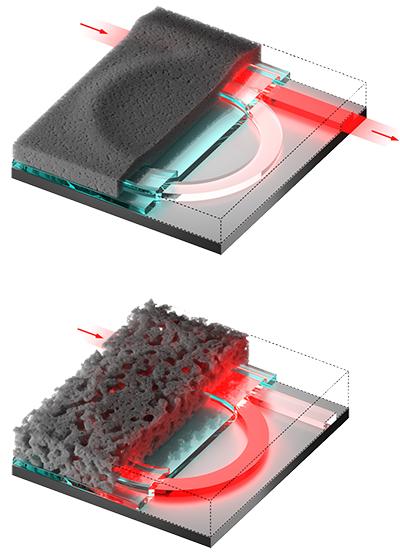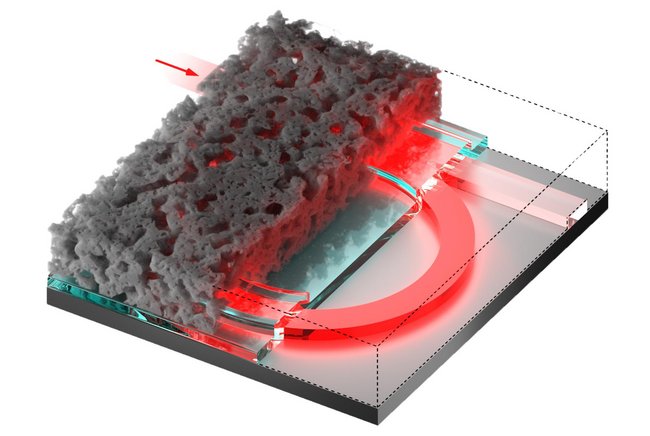MAY 13, 2020
The future looks bright for photonic integrated circuits (PICs) as they look destined for use in quantum computing and deep learning technologies. As PICs carry light signals rather than electrical signals, accurate control of their refractive properties is essential. Traditional techniques for programming photonic devices rely on exposure to light and heat. However, this leads to high power consumption and requires complex control circuits. Researchers from two different departments at Eindhoven University of Technology have developed a new and non-traditional polymer-based approach that significantly reduces the programming time and increases the programming possibilities for PICs. This could radically improve the fabrication yield of programmable PICs. The research has been published in Advanced Optical Materials.
Reprogrammable photonic integrated circuits (PICs) manipulate the path of data-carrying light signals and are made from materials whose refractive index can be changed. To maximize signal control and minimize optical losses, a robust, reliable and rapid method for making PICs is required.
With this in mind, researchers from the department of Electrical Engineering (led by Dr. Mahir Mohammed and Associate Professor Oded Raz) and from the department of Chemical Engineering and Chemistry (led by Christian Sproncken and Professor Ilja Voets) have developed a novel fabrication method for programmable PICs that involves coating photonic materials with polymers whose optical properties can be widely tuned in a matter of minutes using acidic solutions of varying pH. This is a new and unique approach for making programmable PICs as it involves the use of polymers and acidic solutions, rather than exposing photonic materials to light and then regulating the refractive properties using heat.

PEM CLADDING FOR PHOTONIC DEVICES
Before fabricating the new polymer-coated photonic devices, the researchers first confirmed that the optical properties of responsive polyelectrolyte multilayer (PEM) – a material that is made up of a number of PEM layers – could be reversibly changed. PEM-coated silicon samples were subjected to cycles of acidification and neutralization by alternately dipping the samples in solutions of varying pH. A low pH solution (highly acidic) led to thin PEM layers with high refractive index while higher pH solutions (less acidic) resulted in thick PEM layers with a lower refractive index. The decrease in refractive index is due to an increase in the number of holes (increase in porosity) in the material.
The authors then placed a PEM cladding first entirely and then partially over a photonic device. Using the cyclic acidification process, they varied the thickness of the cladding (and as a result its refractive index). This new approach offers a wide range of control and flexibility when it comes to producing programmable photonic devices. Importantly, devices can be programmed in a matter of minutes using the approach. Even more impressively, the programmed state is non-volatile and stable for up to 15 weeks.
STIMULUS FOR COLLABORATION
The stimulus for this inter-departmental collaboration came from Mahir Mohammed: “I read a 2002 paper from a group in MIT who demonstrated the refractive index of PEM could be changed using acidic solutions. We reached out to the CEC department and met with Ilja Voets and her group. The rest as they say is history.” Co-author Christian Sproncken, a PhD candidate in the Self-Organizing Soft Matter Group of Ilja Voets, noted, “It was great to use techniques from my field in a different way. Many will view this as a non-traditional way to make PICs, but we show what is possible with this approach!”
According to Oded Raz, “This is an entirely new direction for making reconfigurable photonics and paves the way for the low-cost mass production of reprogrammable PICs”, while Ilja Voets was also enthusiastic about the findings: “Multidisciplinary collaborations provide an opportunity to concurrently progress multiple fields. This study has shown that our expertise in polymers can be applied in a new and refreshing way leading to the potential for key photonic components in future photonic technologies.”
Full paper: Mahir A. Mohammed et al., “Reversibly Programmable Photonics via Responsive Polyelectrolyte Multilayer Cladding”, Advanced Optical Materials, (2020), (doi: 10.1002/adom.202000325).















